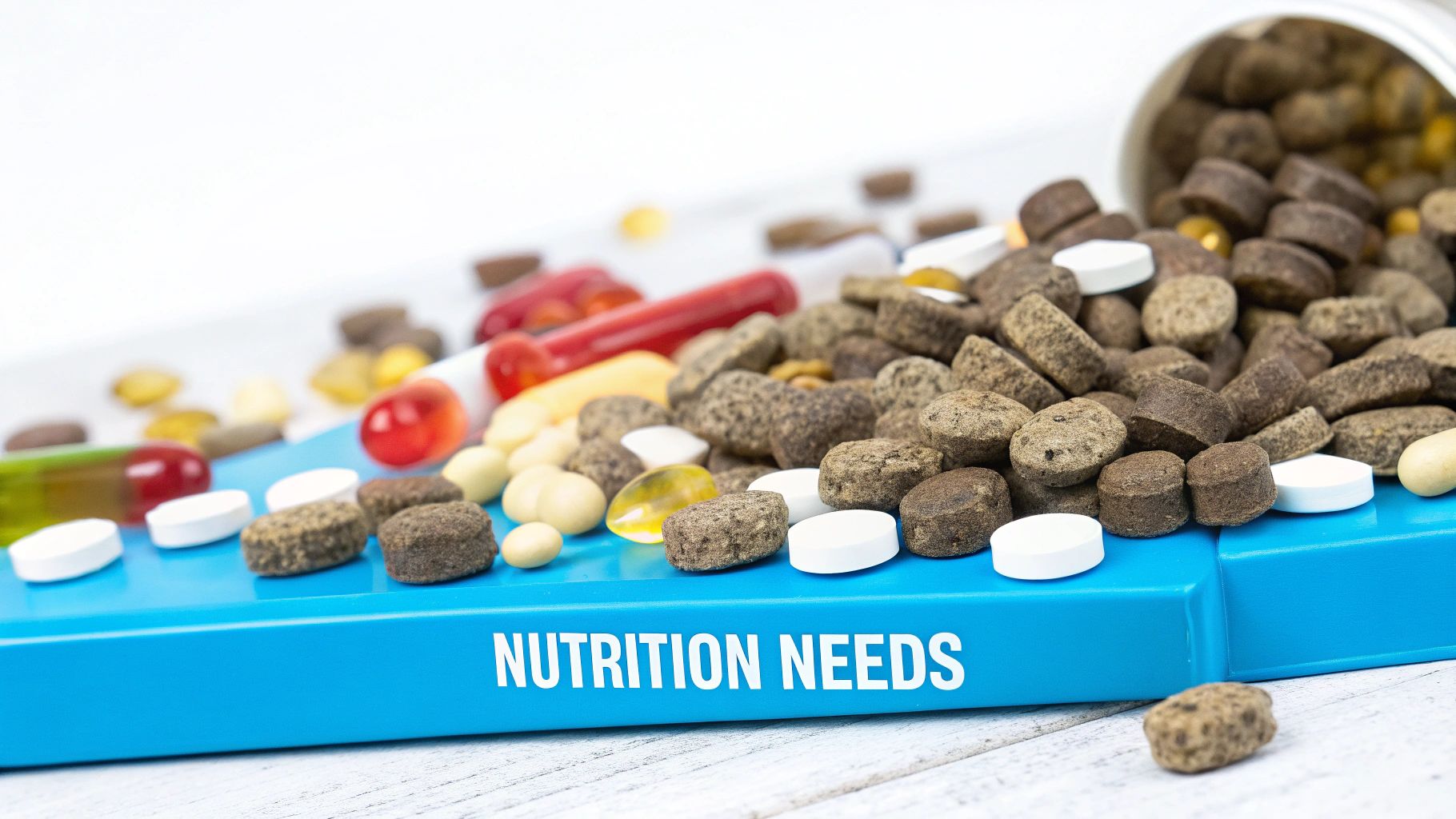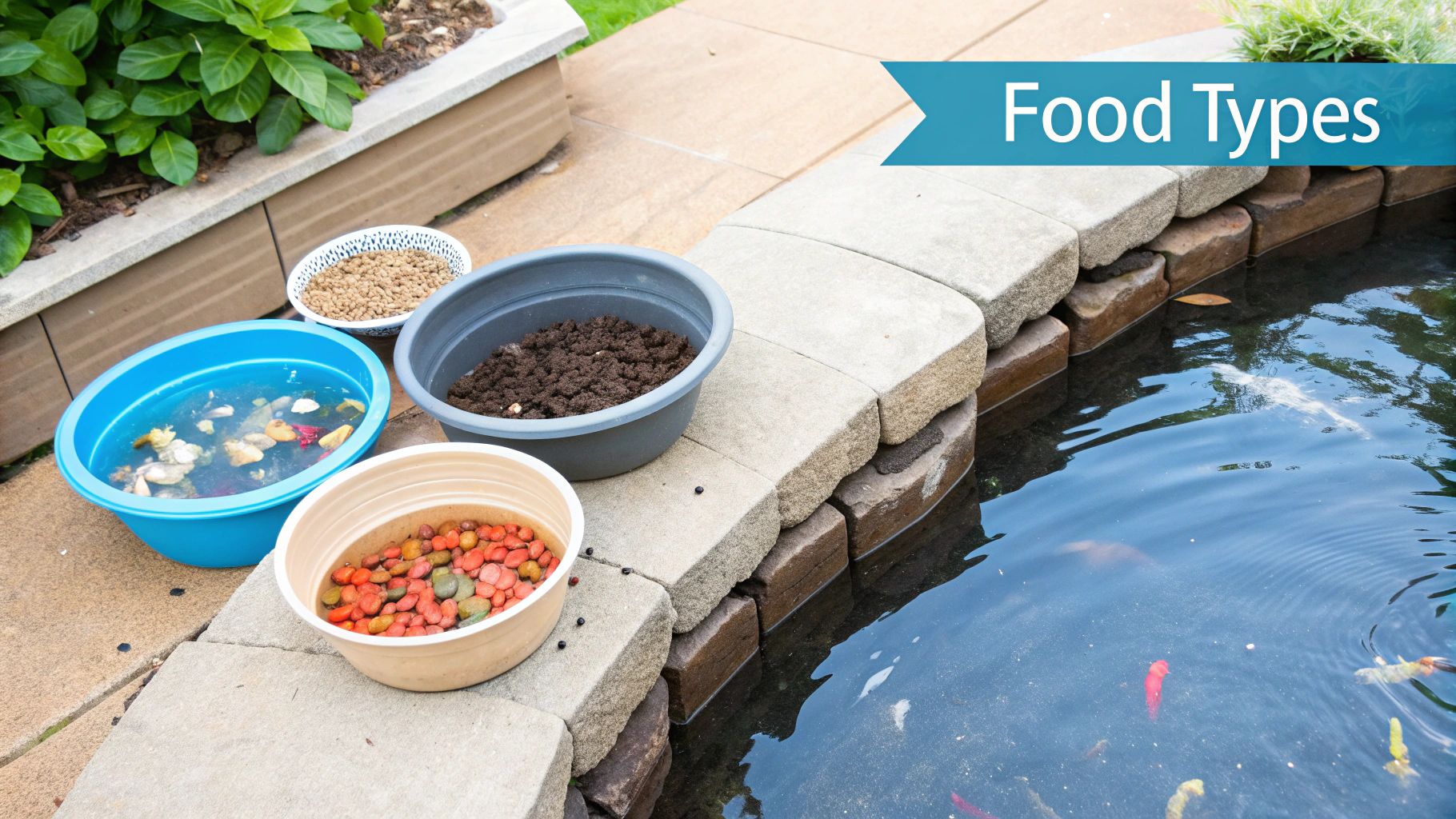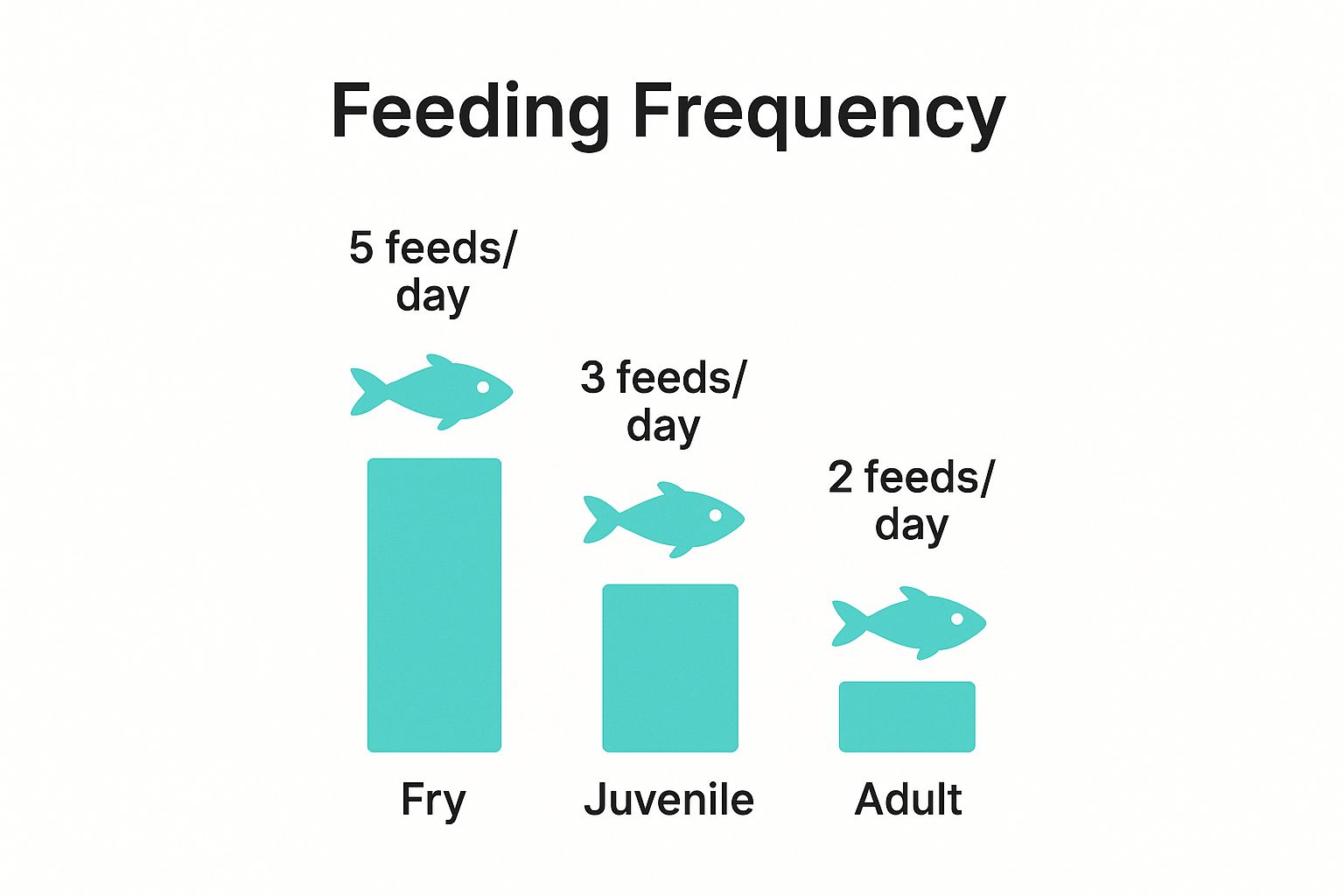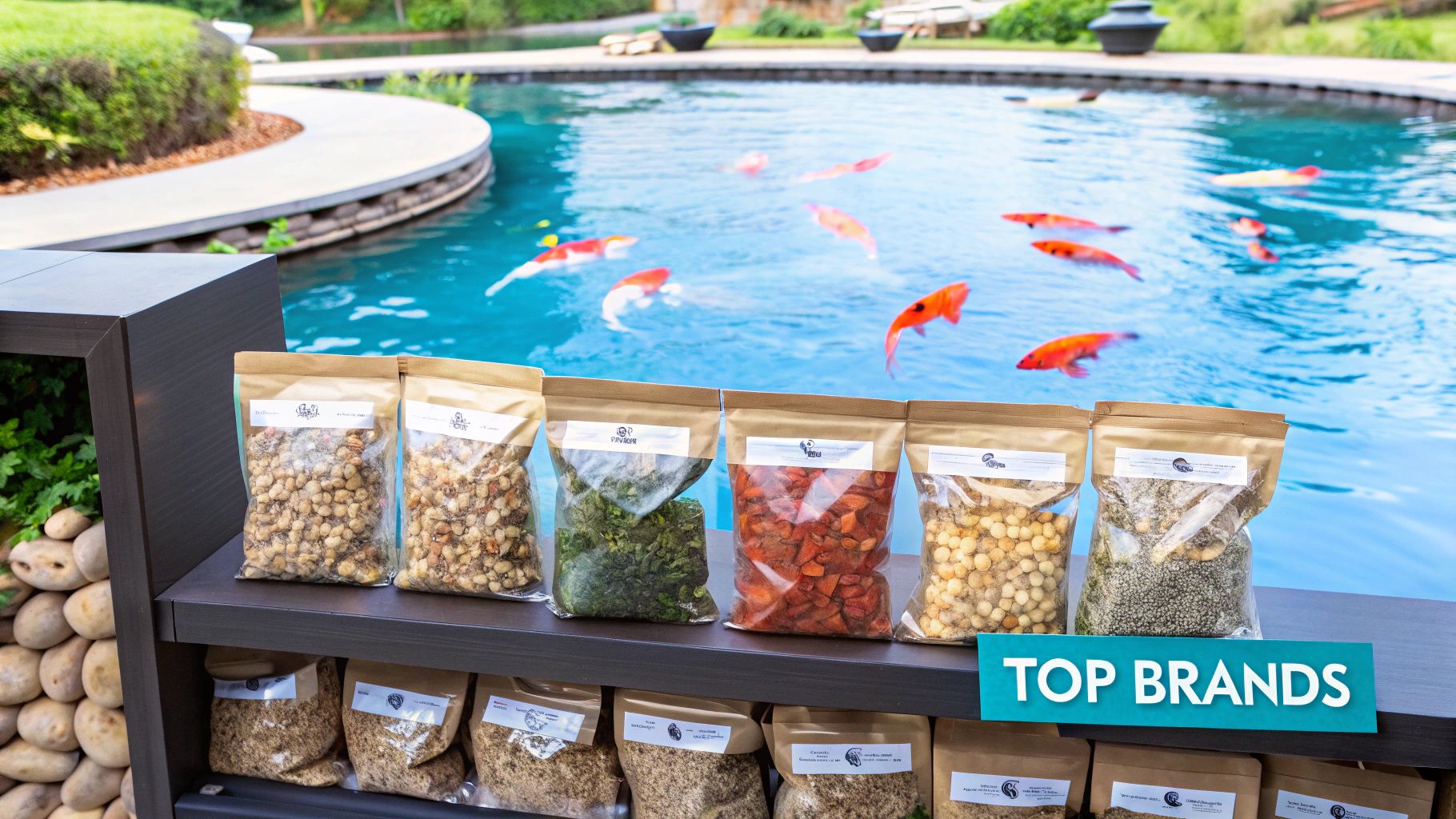The secret to getting your koi to pack on size isn't a magic pellet. It's a smart nutritional game plan. For impressive growth, the best thing you can feed your koi is a high-protein formula, especially during the UK's warmer months when their metabolism is firing on all cylinders.
Think of your koi like athletes. They need specific fuel at different times of the year to build muscle, maintain peak condition, and truly flourish.
Unlocking Your Koi's True Growth Potential
This guide is your roadmap. We'll move past brand names and get into the why behind proper koi nutrition. We will break down the essential building blocks for growth, like protein and fats, explain how to pick the right food, and show you how to tweak your feeding strategy as the UK seasons change. Get ready to learn the methods that will help you raise bigger, healthier, and more stunning koi.
Your pond is a unique little world. Just as a gardener nurtures their soil for the best blooms, a dedicated koi keeper manages nutrition to cultivate impressive size, vibrant colour, and robust health. The journey to growing champion-worthy koi starts with understanding their food.

Why a Specialised Diet Matters
It’s easy to think any fish food will do. But koi have specific dietary needs that generic pond foods can't satisfy. Their requirements shift dramatically with water temperature, age, and your goals as a keeper.
If you're serious about maximum growth, a specialised diet is non-negotiable.
A dedicated growth formula is the foundation for rapid development. It packs the concentrated energy and essential amino acids koi need to build muscle and increase body mass efficiently, especially when their metabolism is at full throttle.
This focused approach ensures every gram of food contributes directly to healthy development instead of being wasted. It's the difference between simply keeping fish alive and helping them reach their full genetic potential.
What to Expect From This Guide
Over the next few sections, we'll unpack the essential components of an effective feeding strategy. You'll learn not just what to feed, but precisely when and why, giving you the confidence to make the best decisions for your pond.
We'll be covering:
- The nutritional cornerstones that power rapid growth.
- Different types of food and their best uses.
- How to adapt your feeding schedule to the UK's climate.
By the end, you'll have a clear plan to transform your feeding routine. You can explore a hand-picked selection of high-quality options in our extensive collection of koi food. This knowledge is your key to unlocking the stunning size and vitality your koi are capable of.
The Building Blocks of Rapid Koi Growth
To understand how to get the best growth, think of it like building a house. You need the proper materials in the right amounts—strong bricks for the structure, mortar to hold it together, and energy for the construction crew. For your koi, these essential materials are the macronutrients in their food: protein, fats, and carbohydrates.
Achieving impressive size and vibrant health boils down to getting this nutritional trio right. Each one plays a distinct, vital role in your koi's development. Get the balance right, and you’ve laid the foundation for maximising growth.

Protein: The Master Builder
Protein is the single most critical nutrient for building size. It's the raw material koi use to construct muscle, repair tissue, and support overall development. Because koi can't produce certain essential amino acids, they must get them from their diet.
High-quality protein sources like fishmeal and krill meal are packed with these amino acids, making them effective for growth. The best koi growth foods feature a protein content between 35% and 40%.
Fats: The High-Octane Fuel
If protein builds the house, fats provide the high-density energy to power the project. Lipids (fats) are a concentrated energy source, allowing koi to spare protein for building muscle instead of burning it for daily activity.
Fats also play other crucial roles:
- Vitamin Absorption: They’re essential for absorbing fat-soluble vitamins like A, D, E, and K, vital for immune function and skeletal health.
- Cellular Health: Fats help maintain the integrity of cell membranes, keeping bodily functions running smoothly.
- Energy Reserve: They provide a dense energy store for periods of rapid growth.
Look for foods containing high-quality fish oils, as these provide the omega-3 and omega-6 fatty acids that koi need to thrive.
Carbohydrates: The Quick Energy Source
Carbohydrates are the immediate, easily accessible fuel for your koi, providing instant energy for swimming and other daily activities.
The key is balance. Too many carbohydrates can be tough for koi to digest. A good growth food uses just enough carbs to fuel daily life, ensuring valuable protein and fats are reserved for building body mass.
Here’s how these nutrients break down in a high-quality growth diet:
Essential Nutrients for Koi Growth
| Nutrient | Primary Function for Growth | Ideal Percentage Range | Common Sources |
|---|---|---|---|
| Protein | Builds muscle, repairs tissue, and supports skeletal development. | 35% - 40% | Fishmeal, krill meal, soybean meal |
| Fats (Lipids) | Provides concentrated energy, aids vitamin absorption, and supports cellular health. | 6% - 10% | Fish oil, krill oil |
| Carbohydrates | Supplies immediate energy for daily activities like swimming and foraging. | 25% - 35% | Wheat germ, corn, rice bran |
| Vitamins & Minerals | Support immune function, colour enhancement, and overall metabolic processes. | Trace amounts | Spirulina, yeast, vitamin premixes |
Getting this balance right separates a maintenance diet from one engineered for growth.
One of the best carbohydrate sources in quality koi food is wheat germ. It provides steady energy while being gentle on the digestive system, which is helpful during the cooler temperatures of spring and autumn.
Understanding ingredients is key to providing excellent year-round care. Learn more in our guide to wheat germ fish food for koi health. Grasping these three building blocks means you're no longer just feeding your koi; you’re providing a scientifically balanced diet designed for maximum growth.
Once you understand the essential nutrients, the next step is choosing the physical form of the food. The best koi food for growth isn't just about what's inside the pellet—its shape and behaviour in the water play a massive role.
Getting the format right ensures all your koi get the nutrition they need and cuts down on waste, which is key for maintaining the clean water required for rapid growth.

Floating Pellets for Easy Monitoring
Floating pellets are the most popular choice for UK koi keepers. They let you turn feeding time into an observation session, giving you a valuable window to monitor the health and appetite of your fish.
When pellets float, you can easily see how much your koi are eating. This helps you follow the crucial 'five-minute rule'—only giving them as much food as they can finish in that time. This simple practice prevents overfeeding, which leads to poor water quality and stunted growth.
Watching your koi eat at the surface also lets you check for any signs of illness or unusual behaviour. It’s an easy, non-intrusive way to perform a daily health check.
Sinking Pellets for Comprehensive Feeding
While floating pellets are excellent, they don't always meet the needs of every fish. Some koi are shy and can be out-competed for food at the surface. Sinking pellets are the perfect solution to ensure these bottom-dwellers get their fair share.
By offering a mix of floating and sinking foods, you can cater to all feeding styles. Sinking pellets drift to the bottom, allowing timid koi to feed without fighting through the frenzy at the surface. This strategy promotes more balanced growth across your collection.
Think of it as setting the dinner table for everyone. The floating pellets are the main course, while sinking pellets are for guests who prefer to eat in a quieter corner. Everyone gets a full meal.
The Importance of Correct Pellet Size
An often overlooked factor is the size of the pellet. A pellet that's too large can be tough for smaller koi to eat, leading to waste. Pellets that are too small might not provide enough substance for larger koi.
Matching the pellet size to the mouth size of your fish makes a huge difference.
- Small Pellets (2-3mm): Ideal for fry and juvenile koi under 15 cm.
- Medium Pellets (4-6mm): Suitable for most adult koi.
- Large Pellets (7-10mm): Best for very large, jumbo koi over 60 cm.
Properly sized pellets are easier to digest, which means more nutrients are absorbed and converted into growth.
Natural Supplements for an Extra Boost
Supplementing a high-quality pellet diet with natural treats can give your koi a boost of vitamins and protein, especially during summer. Offer these in moderation; they should not replace their staple diet.
Healthy, natural supplements include:
- Bloodworms or Daphnia: Rich in protein and excellent for encouraging growth.
- Orange or Watermelon Slices: A great source of Vitamin C.
- Earthworms: Another high-protein treat that koi find irresistible.
Incorporating these elements creates a well-rounded feeding regimen. Understanding how often to offer these foods is just as important. For a detailed breakdown, explore our essential guide to koi fish feeding frequency and portions explained. This approach ensures every fish gets what it needs to reach its full growth potential.
Seasonal Feeding Strategies for the UK Climate
A common mistake is feeding koi the same high-protein food all year. The secret to explosive growth is to sync your feeding schedule with our seasons. A koi's metabolism isn't constant; it speeds up and slows down in response to water temperature.
In summer, your koi are like sprinters, burning energy and needing a high-protein diet. In winter, they're in a state of near-hibernation where feeding them can cause serious health problems. Getting this cycle right is fundamental to growing koi safely.
Summer: The Peak Growth Season
When pond water is between 18°C and 24°C, your koi's metabolism is at its peak. This is the prime growth window in the UK, usually from late May to early September. During these months, their digestive systems can efficiently process nutrient-dense foods.
Switch to a high-quality growth formula with 35-40% protein. Feeding smaller amounts several times a day—two to four times—keeps their metabolism buzzing and provides a constant supply of building blocks for development.
Spring and Autumn: The Transitional Periods
As the weather shifts, so should your feeding strategy. Spring and autumn are transitional periods where water temperature is between 10°C and 17°C. A koi's digestive system is either waking up or slowing down, making it less able to handle rich foods.
Digestibility is key. Switching to a top-notch wheatgerm-based food is ideal. Wheatgerm is an easily digestible carbohydrate that provides energy without straining their system. It’s perfect for supporting their immune function as they prepare for summer or winter.
Winter: The Time for Rest
Once the water temperature drops below 10°C, it is crucial to stop feeding your koi completely. At this temperature, their metabolism has slowed to a crawl and their digestive systems have effectively shut down.
Any food they eat won't be digested. It will rot in their gut, which can lead to severe bacterial infections. They will survive on their stored body fat. Resisting the urge to feed on a mild winter day is vital for their long-term health.
To make these decisions, you need to know your water temperature. A reliable floating pond thermometer is vital for accurate temperature monitoring and takes out the guesswork.

Younger koi need feeding more often to support their rapid development, a principle that is especially critical during the peak summer growth season.
Here’s a simple table to track what to feed and when, tailored for the UK seasons.
UK Seasonal Koi Feeding Guide
| Season / Water Temperature | Recommended Food Type | Ideal Protein % | Daily Feeding Frequency |
|---|---|---|---|
| Summer (18-24°C) | High-Protein Growth Pellets | 35-40% | 2-4 times (small amounts) |
| Spring/Autumn (10-17°C) | Wheatgerm-Based Food | 25-30% | 1-2 times (sparingly) |
| Winter (Below 10°C) | No Food | N/A | Cease all feeding |
This quick-reference guide makes it easy to adapt your feeding as the pond water changes throughout the year.
This seasonal approach is critical. Aligning your feeding to our climate makes the difference. By tailoring the food type and frequency to the pond's temperature, you create the perfect conditions for your koi to not only survive but thrive.
Common Koi Feeding Mistakes to Avoid
Even with the best koi food for growth, simple mistakes can undo your hard work. Growing large koi isn't just about what you feed them; it’s about steering clear of common pitfalls that can stunt their progress.
The most widespread mistake is overfeeding. Koi always seem hungry, but giving them too much leads to serious digestive issues and fouls up your pond water.
Uneaten food breaks down and releases ammonia into the water—a toxic compound that stresses fish, damages gills, and can be fatal. This pollution undermines the clean, stable environment your koi need to grow.

Adopting the Five-Minute Rule
To avoid overfeeding, live by the ‘five-minute rule’. Only throw in an amount of food that your koi can completely finish within five minutes.
If you still see pellets floating after that time, you’ve given them too much. Scoop out the excess with a net and offer less next time. This discipline ensures your koi get the nutrition they need without overwhelming your pond's filtration.
The Pitfalls of Low-Quality or Expired Food
Another error is cutting corners on food quality. Cheaper, generic pond fish food or expired pellets will sabotage your growth goals.
Low-quality foods are often bulked out with cheap fillers like corn, which koi struggle to digest. They lack the high-grade protein required for building muscle mass.
Expired food is an equally serious problem.
Over time, essential vitamins and fatty acids inside pellets break down. This doesn't just strip the food of its nutritional value; it can also cause it to go rancid, making it harmful if eaten.
Always check the expiry date and store your koi food somewhere cool, dark, and dry to keep it fresh.
Ignoring Your Pond's Schedule
Finally, inconsistency is a barrier to growth. This applies to feeding times and, crucially, failing to adjust for the seasons. As covered, feeding a high-protein diet when the water is too cold is a recipe for disaster.
A consistent daily schedule helps regulate your koi’s metabolism, but seasonal adjustments are non-negotiable. Sticking to the temperature-based guidelines for switching between food types is vital for their long-term health.
Sometimes you might run out of their regular diet. It's wise to know what safe alternatives are on hand. You can learn about emergency fish feeding alternatives for your goldfish and koi to be prepared. Avoiding these common mistakes creates the perfect conditions for your koi to flourish.
Your Path to Growing Champion Koi
You've learned the essentials of koi nutrition. This is about a strategic approach that leads to remarkable development. The path to growing larger, healthier koi is built on a few powerful principles, suited to the UK climate.
Think of these takeaways as your keys to success. First, embrace a high-protein diet during the peak summer growth season. Second, read the label—understand the nutritional breakdown of the food you choose. Protein builds muscle, fats provide energy, and the right carbohydrates offer clean fuel.
Your Action Plan for Growth
Next, consider the food's physical form. Use floating pellets to monitor feeding habits. Mix in sinking pellets to ensure less aggressive fish get their share. Crucially, always match pellet size to your fish; it makes a world of difference.
Finally, you must adapt your feeding strategy to the UK’s changing seasons. This seasonal awareness is non-negotiable for serious growth.
Armed with this knowledge, you have the tools to transform your approach. You can now confidently select the best koi food for growth and implement a regimen that helps your koi reach their full genetic potential.
Remember, the ultimate measure of success is in front of you. An active, vibrant, and happy koi is a growing koi. Your own eyes are the most important tool for gauging their health.
This guide has provided a framework for making informed decisions. By applying these principles, you’ll see a significant boost in the size, health, and vitality of your fish. The result? A stunning pond that becomes a true showcase of thriving, champion-sized koi.
Got Questions? We’ve Got Answers
Even with the best plan, questions pop up. As you get to know your fish, you'll start noticing the little details. This section tackles common queries UK koi keepers have when aiming for impressive growth.
Getting these specifics right can put the final polish on your feeding strategy.
How Quickly Can My Koi Grow with the Right Food?
With top-tier food, pristine water, and a warm UK summer, young koi can grow 2-3 cm per month. This pace slows as they get older.
Feeding a high-protein diet when the water is between 18°C and 24°C is the single biggest factor in helping them reach their full potential. Genetics plays a part, but the right food ensures they live up to their blueprint for size.
Can I Use Food for Other Pond Fish for My Koi?
It’s not a good idea. Generic pond fish food doesn't cut it for koi. They have specific needs, especially when pushing for growth and vibrant colours.
A proper koi food is formulated with higher protein levels (35-40%), essential fats, and specific nutrients they need to thrive. Think of it as an investment in their health and appearance.
It's like this: you wouldn't put standard unleaded in a Formula 1 car and expect it to win. Koi are the elite athletes of the pond world; they need premium fuel to perform at their best.
Is It Okay to Give My Koi Treats Like Bread?
It’s best to avoid treats like bread, rice, or peas. These are packed with carbohydrates that a koi's digestive system isn't built to handle. Feeding them these can lead to internal health problems and foul up your water.
If you want to offer a treat during summer, stick to healthy, natural options in moderation. Good choices include:
- Slices of watermelon or orange (a great source of Vitamin C)
- Earthworms
- Bloodworms or daphnia
These give them a nutritional boost without messing with their digestive health.
How Do I Know If I Am Overfeeding My Koi?
The signs are usually obvious. Look for leftover food floating five minutes after feeding, or if your water is constantly cloudy. These are clues that your filter can't keep up.
Another giveaway is high ammonia or nitrite readings on your water test kit. The easiest way to avoid this is to be strict with the 'five-minute rule'. If there's food left after five minutes, scoop it out. This habit is key to maintaining a healthy environment.
At Hatton Koi, we're passionate about helping you get the best from your pond. We stock a carefully chosen selection of high-performance koi foods and all the essential pond supplies to make sure your fish get nothing but the best. Explore our collection and give your koi the nutritional head start they need to flourish.

